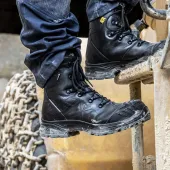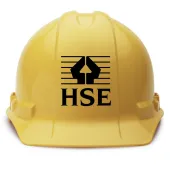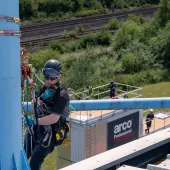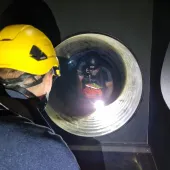The Risks of Excessive Noise: Prevention where there is no cure

First published in the October 2023 issue of Quarry Management
Stuart Marshall, hearing technical specialist at Arco, shares his advice on detecting, controlling, and managing risks in environments with excessive levels of noise exposure
As the world continues to get louder, more and more people are being exposed to dangerous levels of noise on a regular basis. Across Europe, an estimated 450 million people, roughly 65% of the population, live with noise levels that the World Health Organization deems hazardous to health. The dangers surrounding noise can often be overlooked in the hierarchy of health and safety issues within the workplace, however, they pose significant health and safety risks to employees.
According to the Health and Safety Executive (HSE), in 2021–2022 there were an estimated 11,000 workers across the UK suffering from work-related hearing problems. Ten of these cases were severe enough to result in ‘occupational deafness’. Whilst there are procedures and technology that can aid with partial deafness, complete deafness is often incurable, yet, when caused by excessive noise exposure, often preventable in the first place.
The law
The Noise at Work Regulations 1989 first placed legal duties on employers, machinery designers, manufacturers, and suppliers to effectively minimize the risk of hearing damage to employees due to noise at work.
If there is a risk of excessive or consistent noise it is crucial that employers implement monitoring procedures. In industrial workplaces, the Control of Noise at Work Regulations 2005 outline the steps that employers must take to protect their workers from noise-related ailments. Examples of when these measures must be implemented include when noisy power tools are operated for more than 30mins a day, or if it is impossible to maintain a conversation at normal levels when 2m away from a colleague.
Noise monitoring
When monitoring for noise, peak noise level and average noise level are the main considerations. Employers must provide hearing protection and protection zones when a level of 85dB is measured as a daily or weekly average. Information and training must be provided when the daily or weekly average is at the lower limit of 80dB; hearing protection must also be available, but it is not compulsory for workers to wear it.
The upper action level indicates the magnitude of noise at which action must be taken (around 137dB), even if this level of noise is only experienced for very short periods of time. Instantaneous noises can cause immediate and permanent hearing loss. When workers are likely to be exposed to the peak or average noise levels, a noise assessment must be conducted by a competent individual to identify which workers are exposed and to provide the site manager with information that will enable them to implement preventative measures. There is also an exposure limit, even when employees are wearing hearing protection, which is 87dB over an 8h average exposure or 140dB for impact noise.
Several considerations must be taken into account when identifying and measuring the level, exposure, and location of workplace noise. Tasks that involve equipment, machinery, and tools that produce either exceptionally loud or excessive consistent noise should be monitored most closely and employees who require health surveillance should be excused from these tasks or take extra precautions when conducting them. The decibel scale increases threefold, so every three decibel increase is equal to a doubling of the noise intensity.

How to monitor noise:
Monitor noise on site using the correct equipment and by a qualified individual
Use a Class 2, or higher, hand-held noise meter to measure the current level of noise in the surrounding area at a range of frequencies between 63Hz and 8,000Hz
Use a calibrator to check these meters each day, both before and after taking a reading, to ensure they are providing accurate results
If an employee is highly mobile or working in places where measurement access is awkward, a noise dosimeter is a good alternative
Use noise level calculators for guidance on average noise levels over a period.
Noise monitoring equipment needs to be re-certified at least every two years to guarantee employees are protected from the failings of improper equipment. Equally, noise levels need re-checking at least every two years or if there have been changes on site, as the workplace is subject to changes in average noise levels, such as older equipment producing louder noises through increased vibrations.
Businesses that lack the resources or expertise to conduct their own noise monitoring should consult experts who offer monitoring solutions to assess their working environments.
Prevention
The standard hierarchy of control applies when dealing with noise, and removal of the noise hazard from the area should be the first priority. Where this cannot be achieved, noise exposure should be reduced as far as is reasonably practicable. Methods such as using low-noise equipment and installations or isolating workers from the noise hazard can bring the average noise level experienced by the employee down to below the 85dB limit. Other measures that can be taken include removing or reducing sound-radiating surfaces, isolating vibrations, using absorbent linings in vehicle cabs, utilizing exhaust silencers on drill rigs, and using noise refuges for employees.

Personal protective equipment (PPE)
If a workplace exceeds the HSE’s recommended 85dB over an 8h working day, PPE must be issued to protect employees. It is recommended that the PPE provides protection for decibel limits above the required limit, but never to block levels below 70dB, as being unable to hear their surroundings could expose employees to further unnecessary risks, such as moving vehicles.
To ensure suitable noise shielding for employees, companies could consider:
Disposable foam earplugs
Custom-moulded earplugs
Banded hearing protectors
Ear defenders.
Everyone’s ears are different, and protection relies on proper fitting, so companies must consider this. The Single Number Rating (SNR) for ear protection is an idealistic measure of the level of noise it can protect against and does not always consider environmental conditions or the wearer’s fit and comfort. To ensure proper protection, companies should refer to the manufacturer’s information and conduct appropriate noise-level calculations depending on the nature of the work being undertaken.
Ear-fit testing is the only way to ensure that hearing protection does its job optimally. Companies should use the Single Number Rating (SNR) to guarantee industry guidelines are met for the protection, followed by ear-fit testing to ensure the performance of a hearing-protection device remains optimal when individual and environmental factors affect conditions. Simply put, if the ear protection does not fit correctly by forming a seal between the ear and the surroundings, the PPE will not work as intended.
It is essential that companies conduct noise monitoring of their workplaces and provide the necessary noise protection to their employees to prevent them from suffering similar noise-related ailments as the 11,000 people in 2021–2022. Once noise monitoring procedures are in place, they must be regularly checked, if necessary, by an outside expert, to ensure compliance and, more importantly, that employees are protected.
Subscribe to Quarry Management, the monthly journal for the mineral products industry, to read articles before they appear on Agg-Net.com








